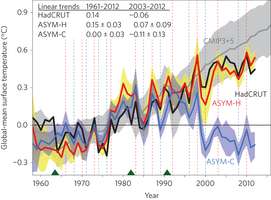September 2, 2014 report
Separate studies suggest current "pause" in global warming likely the last

(Phys.org) —Two different research groups working independently have come to the same conclusion, the current pause we've experienced in global warming (since 1997) is very likely the last we're likely to see if current greenhouse gas emission trends continue. One team, with members from several research centers in Japan, has published their findings in the journal Nature Climate Change. The other, based at the University of New South Wales, in Australia, has published their findings in Geophysical Research Letters.
Most scientists agree that the current pause we are experiencing with global warming is likely due to the ocean serving as a massive heat sink (and a small amount of cooling due to volcanic eruptions). Most also agree that the time is coming soon when the oceans will stop absorbing the excess heat, ending the pause we are experiencing and allowing global temperatures to rise again.
The team in Japan has found, using climate records and models, that natural variations in temperature over the past thirty years have had less of an influence on the overall warmth of the planet than in the past, suggesting, that pauses such as we are now experiencing will have less and less of an impact going forward if the atmosphere continues to heat up. More specifically, their models show that during the 1980's natural atmospheric temperature variations accounted for roughly half of temperature changes that were seen. In the 1990's the percentage fell to just 38 percent and then to 27 percent after the turn of the century. Heading into the future, they predict, warming due to human activities will account for more and more of the changes in temperatures, leaving less variability due to natural causes such as the one that led to the pause we are now experiencing.
The team in Australia ran 31 environmental models and came to the conclusion that if greenhouse gas emissions continue at their current rate, the likelihood of another pause in global warming drops to near zero. Even worse, they suggest that the extra heat that has been pulled into the world's oceans is likely to be released causing a speed-up of global warming. Their models show that even if there is a major volcanic event of the magnitude of Krakatau, for example, the outcome remains the same, a constant increase in global temperatures, i.e. no hiatuses or pauses along the way.
Both groups suggest the catastrophic impact of global warming in the not-too-distant future as seen in their dire predictions can be averted if we act now as a global community to reduce greenhouse gas emissions.
More information: 1. Contribution of natural decadal variability to global warming acceleration and hiatus, Nature Climate Change (2014) DOI: 10.1038/nclimate2355
Abstract
Reasons for the apparent pause in the rise of global-mean surface air temperature (SAT) after the turn of the century has been a mystery, undermining confidence in climate projections. Recent climate model simulations indicate this warming hiatus originated from eastern equatorial Pacific cooling4 associated with strengthening of trade winds5. Using a climate model that overrides tropical wind stress anomalies with observations for 1958–2012, we show that decadal-mean anomalies of global SAT referenced to the period 1961–1990 are changed by 0.11, 0.13 and −0.11 °C in the 1980s, 1990s and 2000s, respectively, without variation in human-induced radiative forcing. They account for about 47%, 38% and 27% of the respective temperature change. The dominant wind stress variability consistent with this warming/cooling represents the deceleration/acceleration of the Pacific trade winds, which can be robustly reproduced by atmospheric model simulations forced by observed sea surface temperature excluding anthropogenic warming components. Results indicate that inherent decadal climate variability contributes considerably to the observed global-mean SAT time series, but that its influence on decadal-mean SAT has gradually decreased relative to the rising anthropogenic warming signal.
2. Maher, N., A. Sen Gupta, and M. H. England (2014), Drivers of decadal hiatus periods in the 20th and 21st centuries, Geophys. Res. Lett., 41, DOI: 10.1002/2014GL060527.
Abstract
The latest generation of climate model simulations are used to investigate the occurrence of hiatus periods in global surface air temperature in the past and under two future warming scenarios. Hiatus periods are identified in three categories: (i) those due to volcanic eruptions, (ii) those associated with negative phases of the Interdecadal Pacific Oscillation (IPO), and (iii) those affected by anthropogenically released aerosols in the mid-twentieth century. The likelihood of future hiatus periods is found to be sensitive to the rate of change of anthropogenic forcing. Under high rates of greenhouse gas emissions there is little chance of a hiatus decade occurring beyond 2030, even in the event of a large volcanic eruption. We further demonstrate that most nonvolcanic hiatuses across Coupled Model Intercomparison Project 5 (CMIP5) models are associated with enhanced cooling in the equatorial Pacific linked to the transition to a negative IPO phase.
Journal information: Nature Climate Change , Geophysical Research Letters
© 2014 Phys.org




















